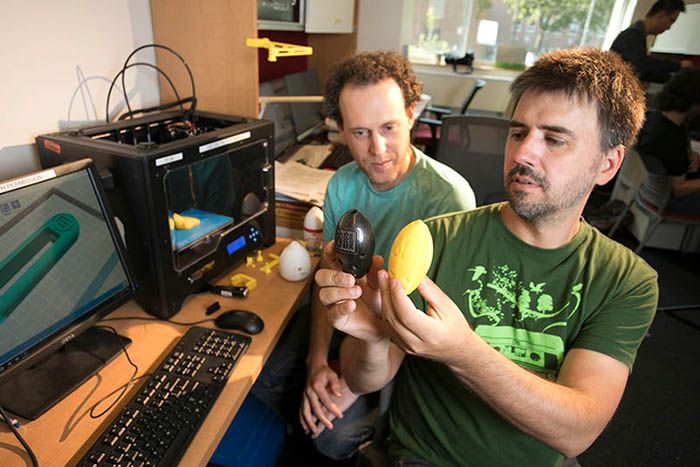
Stony Brook University researchers are using 3D printers to recreate playable replicas of ancient wind instruments, including flutes, ceramic ocarinas, and whistles of different shapes and sizes.
Earlier this year, Stony Brook graduate student and ethnomusicologist Jay Loomis and assistant professor of computer science Roy Shilkrot teamed up to secure a grant for the 3D project. Their goal was to give museum-goers an opportunity to interact with rare instruments rather than merely viewing them through a glass enclosure.
Loomis connected first with Shilkrot and later Hideo Sekino, a visiting professor from Tokyo Institute of Technology, who is associated with the Institute for Advanced Computational Science at Stony Brook.
The collaborators wanted to recreate the sound of the original instrument and mirror its physical characteristics as well. Their greatest challenge was designing the cavity of the instrument, which was essential to recreating the authentic sound.
The early results were encouraging but weren’t as precise as Loomis wanted. cDACT Director Margaret Schedel recommended collaborating with Sekino due to his interest in the traditional Japanese flute known as a shakuhachi. After she introduced the two musicians, Loomis was inspired to feature the instrument in an electronic piece he co-composed with Timothy Vallier.
But it was Sekino’s expertise with 3D printing that led Loomis to seek professor’s advice on how to create a computer program to print ocarinas and other instruments.
Loomis was already able to approximate the sound by adjusting the distance between the holes on the ocarina. “I would fix some holes and print it again and, if I was lucky, it would be a three-step process of trial and error,” said Loomis.
“But I was using a lot of plastic. It would be much easier if I was making them out of clay,” he said. “I asked the professor why couldn’t we look at the size of the holes and create a computer model to simulate the sound of the instrument all on a computer, creating a 3D model based on computer models.”
Sekino said it would be difficult. But three months later he sent Loomis a video of one his friends playing a 3D shakuhachi. Sekino had shot an X-ray of the original instrument and translated that image using software data.
Now Sekino is on board with using 3D printing to create instruments that might otherwise be too labor-intensive to construct.
“His interests are twofold — as a scholar and as a performer,” said Loomis.
Loomis said that the bore, or shape of the inner surface of the tube, is perfectly cylindrical like a PVC pipe. Both Irish flutes and shakuhachis feature conical bores. “If you change the shape of the bore you change the sound of the flute,” he said.
“The project lends itself to creating a bridge among science, music and engineering and the public,” Loomis said.
Loomis added that there is a need to educate the public about indigenous musical instruments, which he does in schools, libraries, camps and for the past five years at Stony Brook University’s Children’s Defense Fund Freedom School.
“At the moment, the only musical instruments for sale in museums are generally children’s toys,” Loomis said.
For the moment, however both Loomis and Sekino are quite content to be fully engaged in the theory of building that better wind instrument and the big payoff — playing it in public.
3D Collaborations Build New Worlds for Musicians was originally published on the Stony Brook University website.